Page 32 of 514
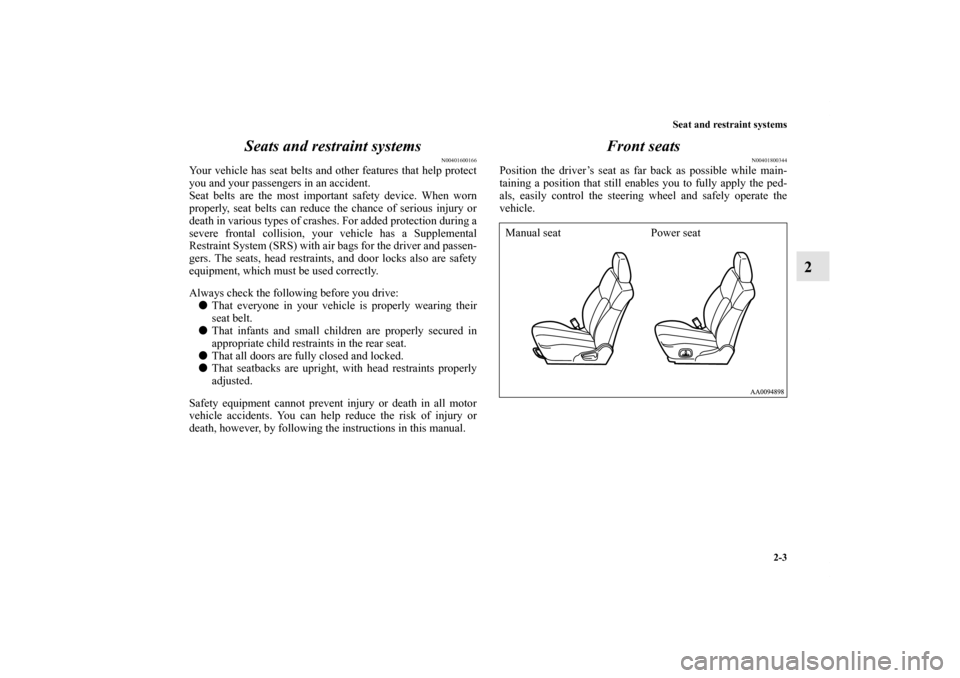
Seat and restraint systems
2-3
2 Seats and restraint systems
N00401600166
Your vehicle has seat belts and other features that help protect
you and your passengers in an accident.
Seat belts are the most important safety device. When worn
properly, seat belts can reduce the chance of serious injury or
death in various types of crashes. For added protection during a
severe frontal collision, your vehicle has a Supplemental
Restraint System (SRS) with air bags for the driver and passen-
gers. The seats, head restraints, and door locks also are safety
equipment, which must be used correctly.
Always check the following before you drive:
�That everyone in your vehicle is properly wearing their
seat belt.
�That infants and small children are properly secured in
appropriate child restraints in the rear seat.
�That all doors are fully closed and locked.
�That seatbacks are upright, with head restraints properly
adjusted.
Safety equipment cannot prevent injury or death in all motor
vehicle accidents. You can help reduce the risk of injury or
death, however, by following the instructions in this manual.
Front seats
N00401800344
Position the driver’s seat as far back as possible while main-
taining a position that still enables you to fully apply the ped-
als, easily control the steering wheel and safely operate the
vehicle.Manual seat Power seat
BK0102600US.book 3 ページ 2009年3月30日 月曜日 午後2時2分
Page 33 of 514
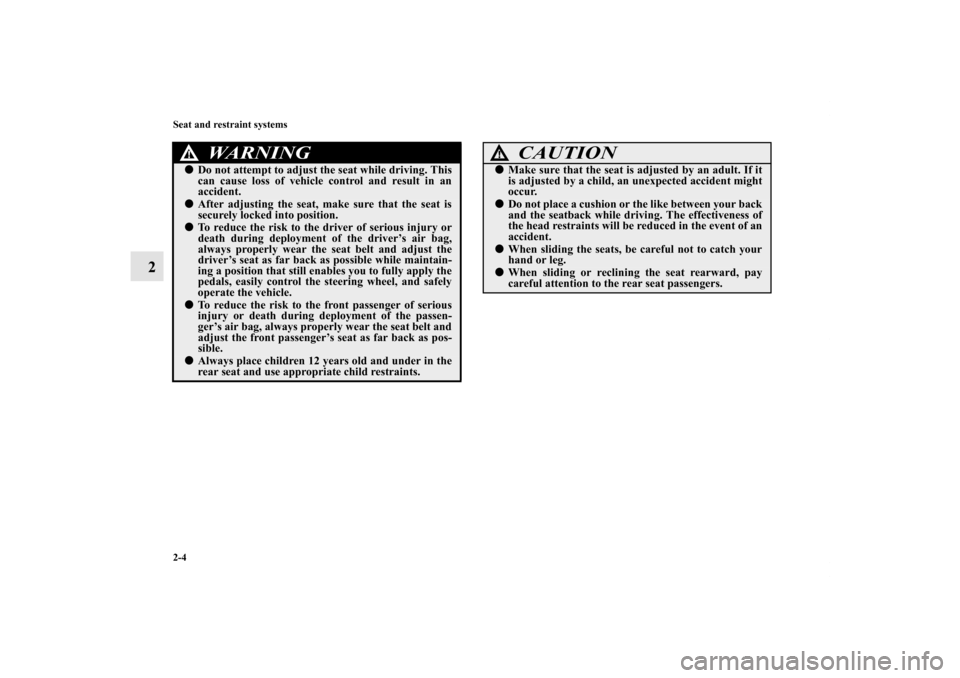
2-4 Seat and restraint systems
2
WA R N I N G
!�Do not attempt to adjust the seat while driving. This
can cause loss of vehicle control and result in an
accident. �After adjusting the seat, make sure that the seat is
securely locked into position.�To reduce the risk to the driver of serious injury or
death during deployment of the driver’s air bag,
always properly wear the seat belt and adjust the
driver’s seat as far back as possible while maintain-
ing a position that still enables you to fully apply the
pedals, easily control the steering wheel, and safely
operate the vehicle.�To reduce the risk to the front passenger of serious
injury or death during deployment of the passen-
ger’s air bag, always properly wear the seat belt and
adjust the front passenger’s seat as far back as pos-
sible. �Always place children 12 years old and under in the
rear seat and use appropriate child restraints.
CAUTION
!�Make sure that the seat is adjusted by an adult. If it
is adjusted by a child, an unexpected accident might
occur.�Do not place a cushion or the like between your back
and the seatback while driving. The effectiveness of
the head restraints will be reduced in the event of an
accident.�When sliding the seats, be careful not to catch your
hand or leg.�When sliding or reclining the seat rearward, pay
careful attention to the rear seat passengers.
BK0102600US.book 4 ページ 2009年3月30日 月曜日 午後2時2分
Page 34 of 514
Seat and restraint systems
2-5
2
To adjust the seat forward or backward
N00401900286
Manual seatPull the seat adjusting lever up and slide the seat forward or
backward to the desired position. Release the adjusting lever to
lock the seat in place.
Power seatPush the switch to adjust the seat forward or backward to the
desired position. Release the switch, and the seat will lock at
that position.NOTE�To prevent the battery from running down, operate the
power seat with the engine running.
WA R N I N G
!�To make sure that the seat is securely locked, try to
move it forward or backward without using the
adjusting lever.
1- Forward (toward the front of the vehicle)
2- Backward (toward the rear of the vehicle)
BK0102600US.book 5 ページ 2009年3月30日 月曜日 午後2時2分
Page 35 of 514
2-6 Seat and restraint systems
2
To adjust the seatback
N00402000314
Manual seatTo adjust the seatback, lean forward slightly, gently pull the
seatback lock lever up, then lean backward to a comfortable
position and release the lever. The seatback will lock in place.
Power seatAdjust the seatback angle by operating the switch as indicated
by the arrows.NOTE�To prevent the battery from running down, operate the
power seat with the engine running.
CAUTION
!�The reclining mechanism used in the seatback is
spring loaded, and will cause the seatback to return
quickly to the vertical position when the lock lever is
operated. When pulling the lever, sit close to the
seatback or hold the seatback with your hand to
control its return motion.
1- To move forward
2- To recline backward
BK0102600US.book 6 ページ 2009年3月30日 月曜日 午後2時2分
Page 39 of 514
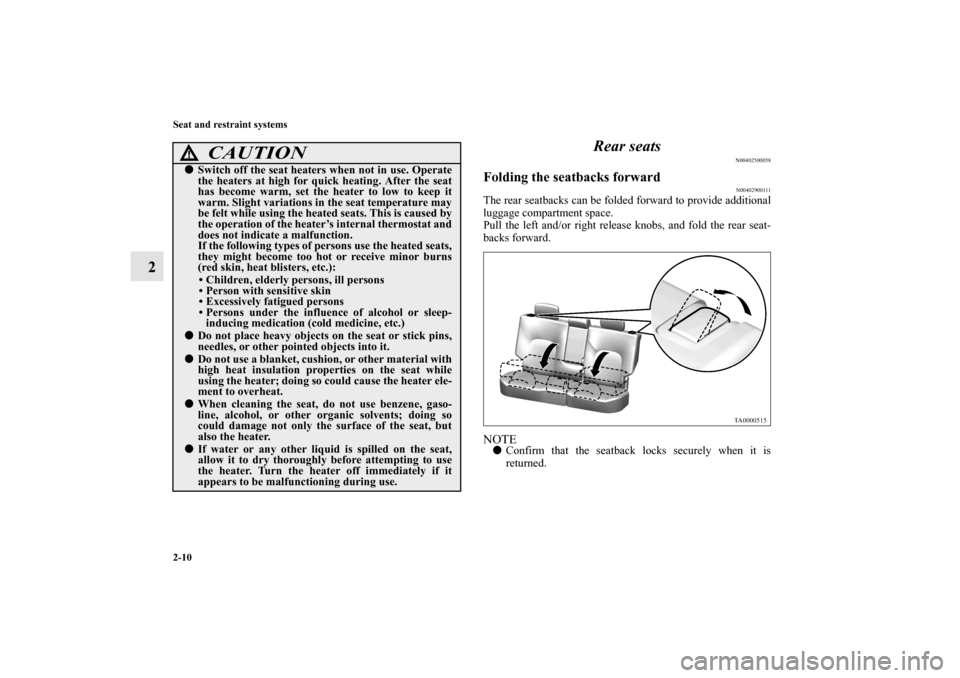
2-10 Seat and restraint systems
2Rear seats
N00402500058
Folding the seatbacks forward
N00402900111
The rear seatbacks can be folded forward to provide additional
luggage compartment space.
Pull the left and/or right release knobs, and fold the rear seat-
backs forward.NOTE�Confirm that the seatback locks securely when it is
returned.
CAUTION
!�Switch off the seat heaters when not in use. Operate
the heaters at high for quick heating. After the seat
has become warm, set the heater to low to keep it
warm. Slight variations in the seat temperature may
be felt while using the heated seats. This is caused by
the operation of the heater’s internal thermostat and
does not indicate a malfunction.
If the following types of persons use the heated seats,
they might become too hot or receive minor burns
(red skin, heat blisters, etc.):
• Children, elderly persons, ill persons
• Person with sensitive skin
• Excessively fatigued persons
• Persons under the influence of alcohol or sleep-
inducing medication (cold medicine, etc.)
�Do not place heavy objects on the seat or stick pins,
needles, or other pointed objects into it.�Do not use a blanket, cushion, or other material with
high heat insulation properties on the seat while
using the heater; doing so could cause the heater ele-
ment to overheat.�When cleaning the seat, do not use benzene, gaso-
line, alcohol, or other organic solvents; doing so
could damage not only the surface of the seat, but
also the heater.�If water or any other liquid is spilled on the seat,
allow it to dry thoroughly before attempting to use
the heater. Turn the heater off immediately if it
appears to be malfunctioning during use.
BK0102600US.book 10 ページ 2009年3月30日 月曜日 午後2時2分
Page 42 of 514
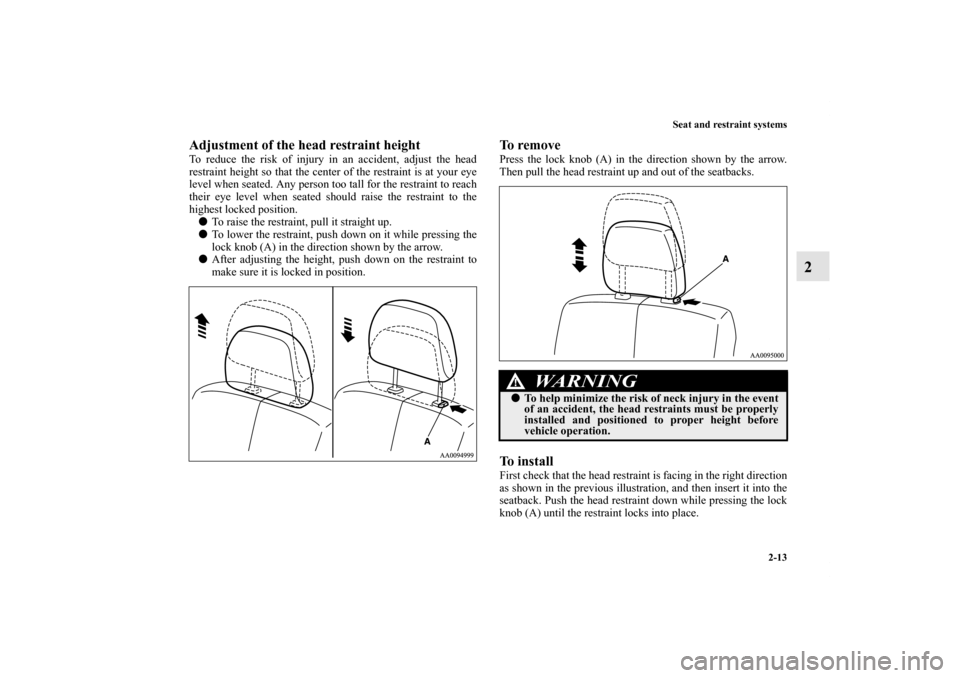
Seat and restraint systems
2-13
2
Adjustment of the head restraint heightTo reduce the risk of injury in an accident, adjust the head
restraint height so that the center of the restraint is at your eye
level when seated. Any person too tall for the restraint to reach
their eye level when seated should raise the restraint to the
highest locked position.
�To raise the restraint, pull it straight up.
�To lower the restraint, push down on it while pressing the
lock knob (A) in the direction shown by the arrow.
�After adjusting the height, push down on the restraint to
make sure it is locked in position.
To r e m o v ePress the lock knob (A) in the direction shown by the arrow.
Then pull the head restraint up and out of the seatbacks.To installFirst check that the head restraint is facing in the right direction
as shown in the previous illustration, and then insert it into the
seatback. Push the head restraint down while pressing the lock
knob (A) until the restraint locks into place.
WA R N I N G
!�To help minimize the risk of neck injury in the event
of an accident, the head restraints must be properly
installed and positioned to proper height before
vehicle operation.
BK0102600US.book 13 ページ 2009年3月30日 月曜日 午後2時2分
Page 43 of 514
2-14 Seat and restraint systems
2
CAUTION
!�Check that the lock knob (A) is extended out as
shown in the illustration. Then pull the head
restraint up to make sure that it is locked in place
and will not come out of the seatback.
CAUTION
!�The shape and size of the head restraint differs
according to the seat. Always use the correct head
restraint provided for the seat and do not install the
head restraint in the wrong direction.
BK0102600US.book 14 ページ 2009年3月30日 月曜日 午後2時2分
Page 45 of 514
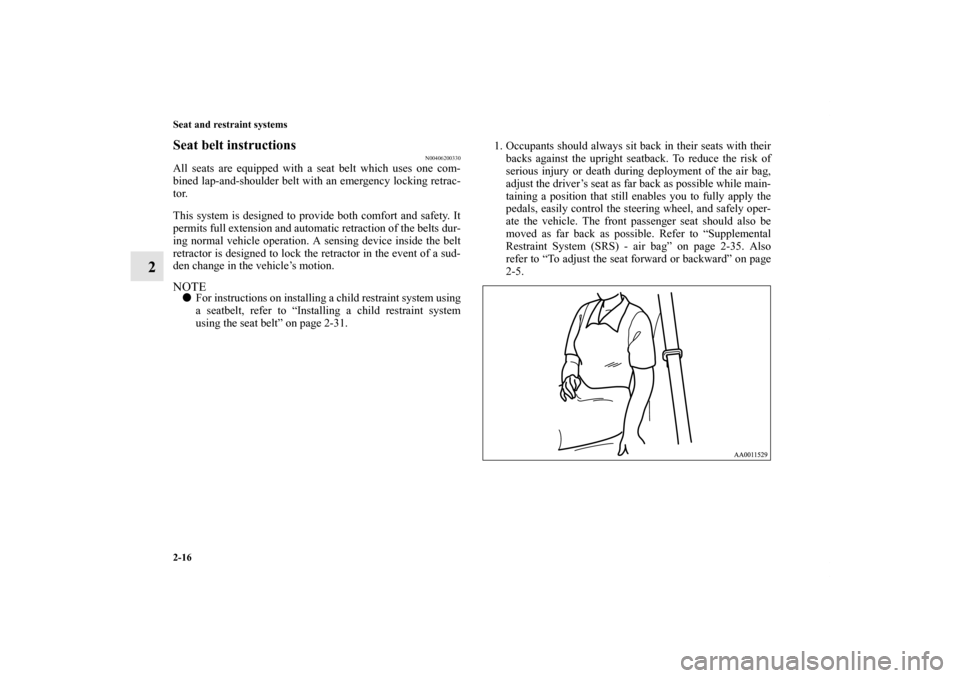
2-16 Seat and restraint systems
2
Seat belt instructions
N00406200330
All seats are equipped with a seat belt which uses one com-
bined lap-and-shoulder belt with an emergency locking retrac-
tor.
This system is designed to provide both comfort and safety. It
permits full extension and automatic retraction of the belts dur-
ing normal vehicle operation. A sensing device inside the belt
retractor is designed to lock the retractor in the event of a sud-
den change in the vehicle’s motion. NOTE�For instructions on installing a child restraint system using
a seatbelt, refer to “Installing a child restraint system
using the seat belt” on page 2-31.1. Occupants should always sit back in their seats with their
backs against the upright seatback. To reduce the risk of
serious injury or death during deployment of the air bag,
adjust the driver’s seat as far back as possible while main-
taining a position that still enables you to fully apply the
pedals, easily control the steering wheel, and safely oper-
ate the vehicle. The front passenger seat should also be
moved as far back as possible. Refer to “Supplemental
Restraint System (SRS) - air bag” on page 2-35. Also
refer to “To adjust the seat forward or backward” on page
2-5.
BK0102600US.book 16 ページ 2009年3月30日 月曜日 午後2時2分